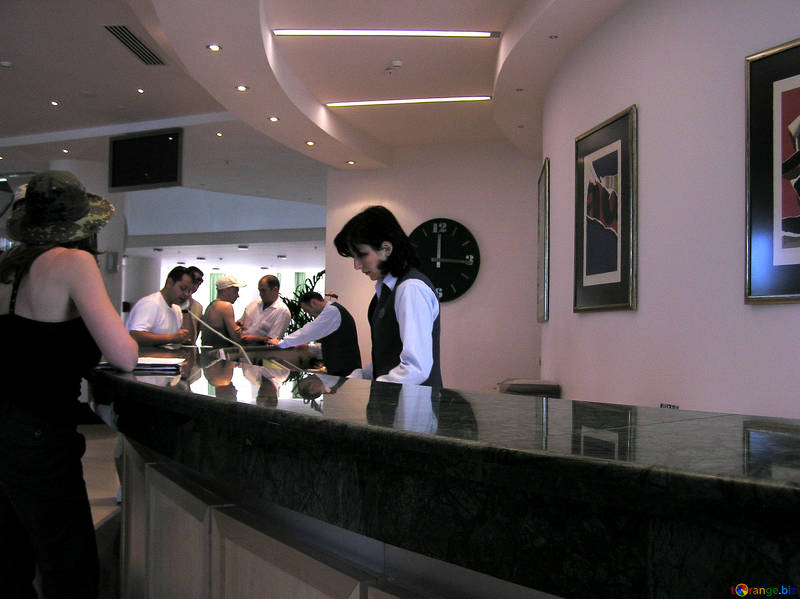Many of the people who travel prefer to be able to communicate in their own mother tongue at the place of destination. So much so that this aspect can be decisive when deciding on one provider or another. The traveler chooses to contract services in which they can express themselves in their language, since this is the key to be able to transmit their wishes and concerns, in this way they feel more secure, especially in case they need help or there is some unforeseen . For the traveler it is very disconcerting not to be understood.

Free picture (Guests of the hotel near the reception) from https://torange.biz/guests-hotel-near-reception-22030
Undoubtedly, the language most used when traveling is English, but what happens with Spanish? Is it important that the recipients speak Spanish?
According to the data collected in the document “El español: una lengua viva”, Informe 2016 (“Spanish: a living language”, 2016 Report), published by the Cervantes Institute, in the sections “El español en cifras” (“Spanish in figures”) and “Previsión de crecimiento” (“Growth forecast”) respectively:
- “In 2016, more than 472 million people have Spanish as their mother tongue. In turn, the group of potential users of Spanish in the world (figure that brings together the group of native domain, the group of limited competence and the group of foreign language learners) reaches almost 567 million.
- Spanish is the second mother tongue in the world by number of speakers, after Mandarin Chinese, and also the second language in a global counting of speakers (native domain + limited competence + Spanish students).
- For demographic reasons, the percentage of the world population that speaks Spanish as a native language is increasing, while the proportion of Chinese and English speakers decreases.
- In 2016, 7.8% of the world population is Spanish-speaking (those almost 567 million potential Spanish users mentioned in the first line). Forecasts estimate that in 2050 Spanish speakers will continue to be 7.8% of the world population. However, these forecasts also predict that, in 2100, this percentage will be at 6.6%, mainly due to the decrease in the population of the Spanish-speaking countries.
- More than 21 million students study Spanish as a foreign language. “

Free picture (Book Club) from https://torange.biz/book-club-34945
Growth forecast
“The analysis of the demographic evolution of the five most spoken languages of the world – Chinese, English, Spanish, Hindi and Arabic – between 1950 and 2050 reflects that, in relative terms, the proportion of native speakers of Chinese and English decreases for reasons of world demography. On the contrary, both Spanish and Hindi are experiencing a moderate but continuous increase in their number of speakers. Arabic, although it shows a lower level of use, shows a greater relative growth.
In fact, based on the methodology used to perform the calculation of speakers contained in the previous tables, the projections indicate that the Spanish-speaking community will continue to grow to reach, in 2050, the 754 million people, with different degrees of mastery of the language. However, this trend is reversed in 2100, year in which there is a decline in the number of Spanish speakers. “
After knowing all these data, undoubtedly it is of great interest, especially in the tourism sector, to have teams of people who can communicate in Spanish to serve customers in their own language, this aspect being a very important point that the client will take into account and may even be decisive when hiring the different services that are included in a trip.
When it comes to learning Spanish, we must keep in mind what the objective is: “why do we want to learn Spanish?” And depending on the answer, choose the course to be studied. If our objective is to apply Spanish to the tourist area, it is best to take a course focused on this sector, giving priority to the situations that arise in that area. This philosophy is followed in Samakela, where Spanish courses are taught, both online and face-to-face, prepared according to the student’s objective so that they can quickly apply the acquired knowledge.
In Samakela you can find Spanish courses aimed at different sectors and also of general scope, or specific on a specific aspect of Spanish. As for the levels, several are offered, always respecting the guidelines set out in the Curriculum Plan of the Cervantes Institute and therefore the European Reference Framework. In Samakela priority is given to student interests and personalized study plans are developed. Visit the website and get in touch with them if you want to learn Spanish and achieve your goals.
EL IDIOMA DEL VIAJERO: EL ESPAÑOL
Gran parte de las personas que viajan prefiere poder comunicarse en su propio idioma materno en el lugar de destino. Tanto es así que este aspecto puede ser decisivo a la hora de decantarse por un proveedor u otro. El viajero opta por contratar servicios en los que se pueda expresar en su idioma, ya que este es la clave para poder transmitir sus deseos e inquietudes, de este modo se siente más seguro, especialmente en el caso de que necesite ayuda o haya algún imprevisto. Para el viajero resulta muy desconcertante no ser entendido.
Sin lugar a duda, el idioma más empleado a la hora de viajar es el inglés, pero ¿qué sucede con el español? ¿Es importante que los receptores hablen español?
Según los datos que se recogen en el documento “El español: una lengua viva”, Informe 2016, publicado por el Instituto Cervantes, en las secciones “El español en cifras” y “Previsión de crecimiento” respectivamente:
- “En 2016, más de 472 millones de personas tienen el español como lengua materna. A su vez, el grupo de usuarios potenciales de español en el mundo (cifra que aglutina al grupo de dominio nativo, al grupo de competencia limitada y al grupo de aprendices de lengua extranjera) alcanza casi 567 millones.
- El español es la segunda lengua materna del mundo por número de hablantes, tras el chino mandarín, y también la segunda lengua en un cómputo global de hablantes (dominio nativo + competencia limitada + estudiantes de español).
- Por razones demográficas, el porcentaje de población mundial que habla español como lengua nativa está aumentando, mientras que la proporción de hablantes de chino e inglés desciende.
- En 2016, el 7,8 % de la población mundial es hispanohablante (esos casi 567 millones de usuarios potenciales de español mencionados en la primera línea). Las previsiones estiman que en 2050 los hispanohablantes seguirán siendo el 7,8 % de la población mundial. Sin embargo, dichas previsiones también pronostican que, en 2100, este porcentaje se situará en el 6,6 %, debido fundamentalmente al descenso de la población de los países hispanohablantes.
- Más de 21 millones de alumnos estudian español como lengua extranjera.”
Previsión de crecimiento
“El análisis de la evolución demográfica de las cinco lenguas más habladas del mundo —chino, inglés, español, hindi y árabe— entre 1950 y 2050 refleja que, en términos relativos, la proporción de hablantes nativos de chino e inglés desciende por razones de demografía mundial. Por el contrario, tanto el español como el hindi están conociendo un aumento moderado, pero continuo, de su número de hablantes. El árabe, aunque muestra un nivel menor de uso, presenta un mayor crecimiento relativo.
De hecho, tomando como base la metodología empleada para realizar el cálculo de hablantes contenido en los cuadros anteriores, las proyecciones indican que la comunidad hispanohablante seguirá creciendo para situarse, en 2050, en los 754 millones de personas, con distinto grado de dominio de la lengua. Sin embargo, esta tendencia se invierte en 2100, año en el que se observa un retroceso en el número de hablantes de español.”
Tras conocer todos estos datos, sin duda alguna resulta de gran interés, especialmente en el sector turístico, contar con equipos de personas que puedan comunicarse en español para dar servicio a los clientes en su propio idioma, siendo este aspecto un punto muy importante que el cliente va a tener en cuenta y que puede llegar incluso a ser decisivo a la hora de contratar los diferentes servicios que se incluyen en un viaje.
A la hora de aprender español, hay que tener muy presente cuál es el objetivo: “¿para qué queremos aprender español?” Y en función de la respuesta, elegir el curso a estudiar. Si nuestro objetivo es aplicar el español al ámbito turístico, lo mejor es realizar un curso centrado en este sector, dando prioridad a las situaciones propias que se dan en dicho ámbito. Esta filosofía es la que se sigue en Samakela, donde se imparten cursos de español, tanto on line como presenciales, elaborados según el objetivo del estudiante para que rápidamente pueda aplicar los conocimientos adquiridos.
En Samakela puedes encontrar cursos de español dirigidos a distintos sectores y también de ámbito general, o específicos sobre un aspecto concreto del español. En cuanto a los niveles se ofrecen varios, siempre respetando las directrices marcadas en el Plan Curricular del Instituto Cervantes y por tanto el Marco de Referencia Europeo. En Samakela se da prioridad a los intereses de los estudiantes y se desarrollan planes de estudio personalizados. Visita el sitio web y ponte en contacto con ellos si quieres aprender español y alcanzar tus objetivos.
Among his passions is African culture and arts.
Contact: anairenegp@samakela.com
![]()
Samakela Ediciones